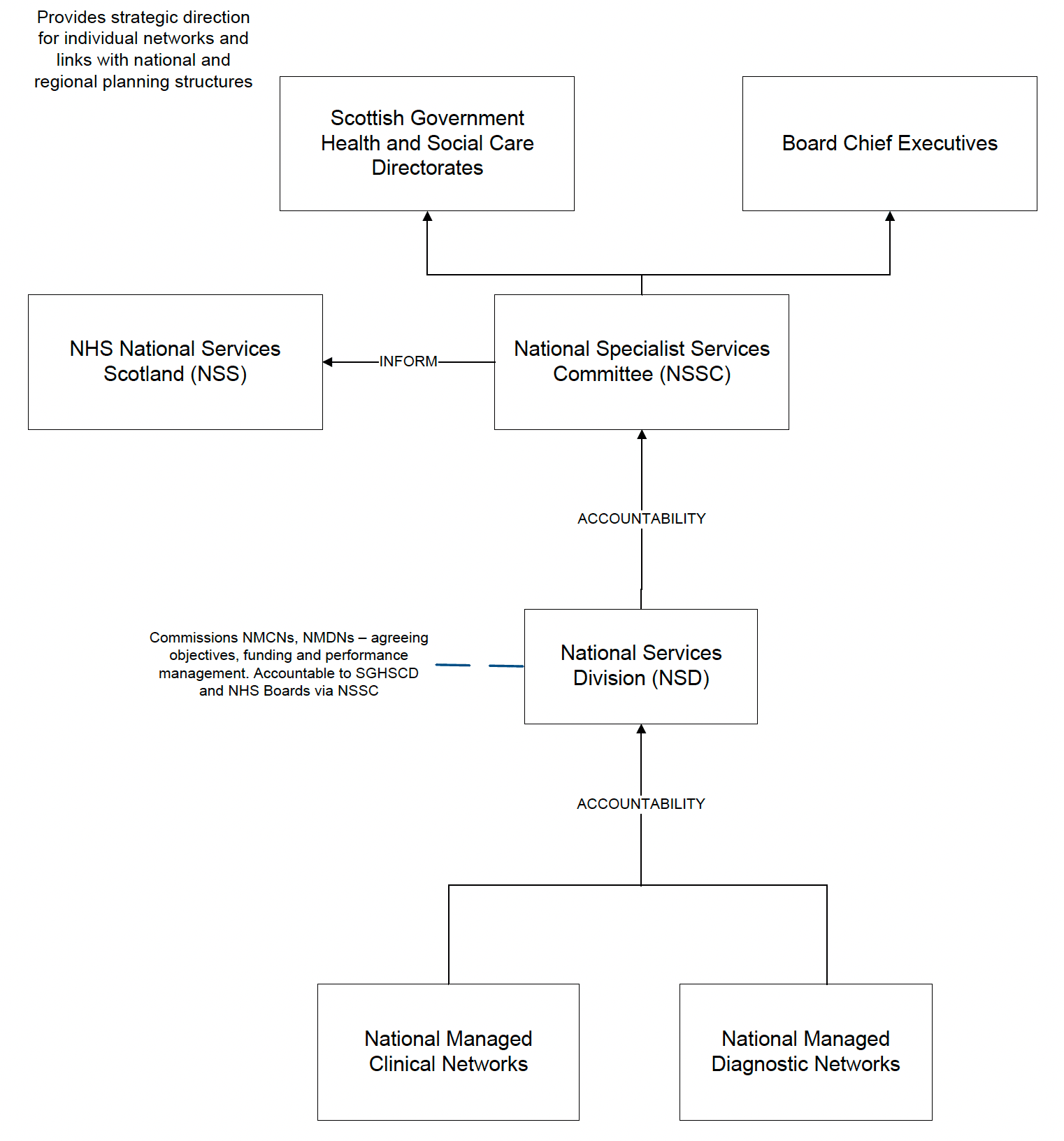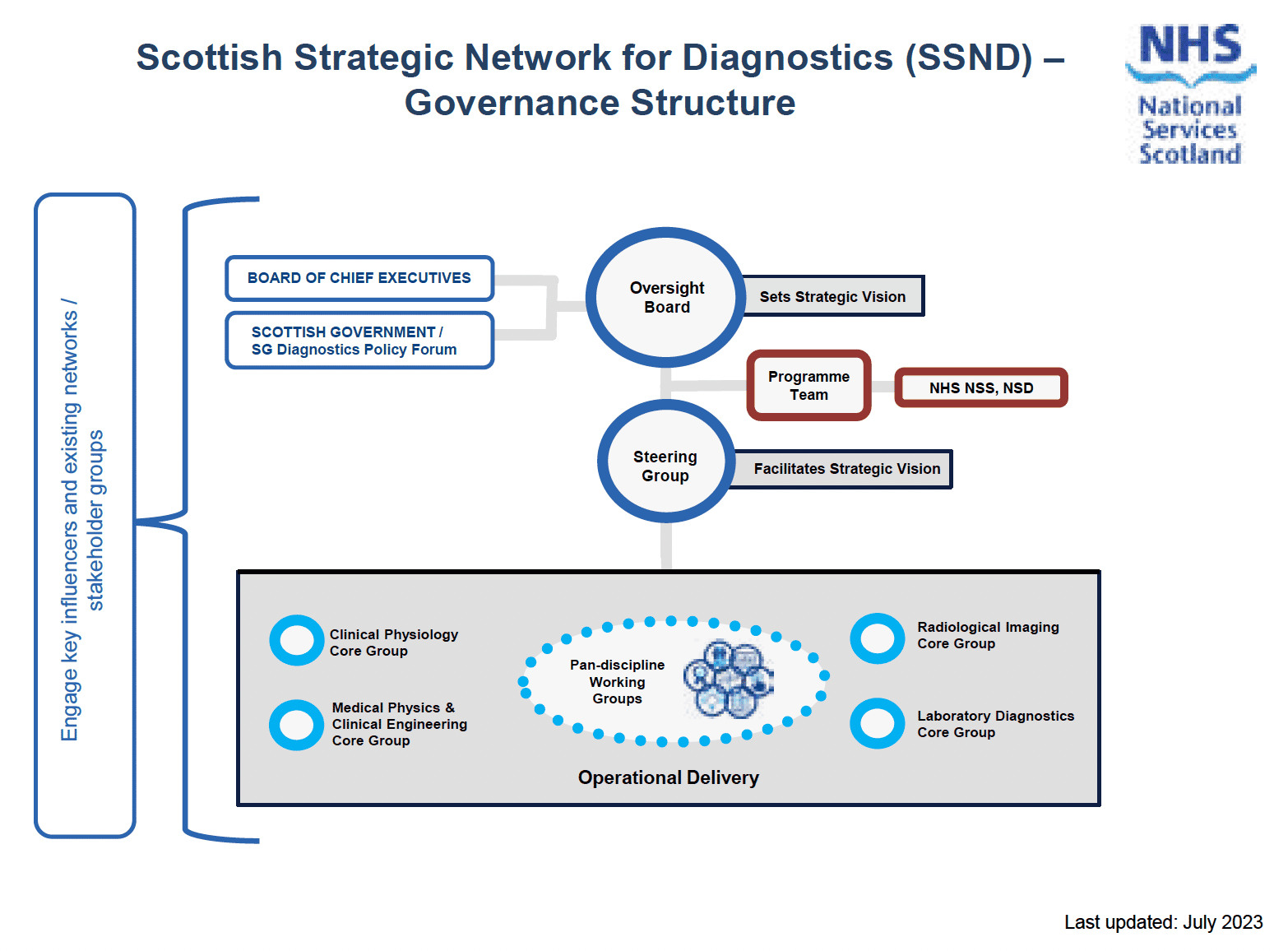Independent Review of Audiology Services in Scotland
Review report and recommendations from the Independent Review of Audiology Services in NHS Scotland. The Review was announced by the Scottish Government in January 2022 in the context of failings in the standards of care provided in the NHS Lothian Paediatrics Services.
National structure of audiology services
Key points
- No single body has oversight of and responsibility for paediatric and adult audiology services in Scotland.
- Organisations involved in delivering audiology care have varying governance structures and different lines of reporting.
- Complex systems can have a detrimental effect on the quality of care.
- The Scottish Government Chief Scientific Officer provides professional leadership to more than 50 Healthcare Science specialties, including audiology.
As outlined in the Introduction, the approach taken and the structure of the Review were mirrored by the Sub-Group that looked at structure, governance and leadership. The findings from this Sub-Group are summarised in a separate section of this report.
The organisation of audiology services in Scotland is complex, but can be described as follows:
- a combination of those provided locally by territorial Health Boards and those commissioned nationally (by the National Services Division (NSD) of NHS National Services Scotland) but provided by one Health Board for Scotland (SCIP);
- a national Universal Newborn Screening Programme (UNHS), also delivered by Health Boards;
- a managed clinical network responsible for children and young people with hearing loss (there is currently no equivalent network for adults).
These elements have varying governance structures and different lines of reporting. In Scotland, there is no single body which either has an overview of all paediatric and adult audiology services, or responsibility for them. Complex systems like this can result in fragmentation of care, poor integration and coordination of services, and suboptimal transitions of care. As highlighted earlier, children and adults require patient pathways that are timely, effective and coordinated to achieve the best possible outcomes.
Adult audiology services are delivered by 14 territorial Health Boards, and paediatric audiology services by 11.
Universal Newborn Hearing Screening (UNHS) programme
The UNHS programme was rolled out in Scotland in 2005. Though a national screening programme, it is not commissioned nationally and delivery is the responsibility of each of the 14 Health Boards.
Pregnancy and newborn screening public health consultants are responsible for each Board’s delivery of UNHS. Governance and quality assurance are provided by the lead clinician and senior programme manager (a role performed by NSD).
The national UNHS KPIs are reported quarterly and annually, and an annual national UNHS report covering all statistical data is reported via the National Screening Oversight Board, Scottish Screening Committee and, ultimately, to the Scottish Government.
There are clinical standards for pregnancy and newborn screening, which apply to all screening programmes. Healthcare Improvement Scotland has a mandatory role in external quality assurance of screening programmes, though to date UNHS standards have never been externally assessed.
In 2021 the Scottish Government requested that a national UNHS short life working group (SLWG) be established to explore the challenges facing the UNHS programme and make recommendations to ensure its ongoing delivery.
The SLWG reported in February 2021 (11), making a range of recommendations on screening protocols, equipment, workforce, training and CPD, quality assurance and clinical governance, and patient management systems.
Many of these themes are also reflected in the main Review findings. We fully endorse and recommend implementation of all the recommendations from the SLWG.
Scottish Cochlear Implant Programme (SCIP)
The SCIP, based at University Hospital Crosshouse, provides a national cochlear implant service for severe to profoundly deaf children and adults in Scotland.
NHS Ayrshire and Arran is commissioned by NSD to deliver this nationally designated service.
The requirements of the service are specified in a service-level agreement covering all aspects of service delivery including: inclusion criteria and activity levels; performance and clinical outcomes; quality and service improvements; governance and regulation; audit and clinical research; finance; workforce and forward-planning.
The service is required to submit data and reports to NSD at specified time intervals throughout the year. This includes submitting data on a monthly basis via the specialist services dashboard and submitting a comprehensive annual report. The annual report is extensive and covers a wide range of measures, including measures for giving assurance of service quality, effectiveness and performance.
NSD monitors these measures and reserves the right to request improvement plans where appropriate.
An annual performance review is also undertaken each year by NSD based on ongoing discussions and the service’s annual report.
Hearing Impairment Network for Children and Young People (HINCYP)
HINCYP is a national managed clinical network (MCN) (12). Funding was approved in 2019 and the network was launched in 2020. A scoping project commissioned by the Scottish Government in 2015 concluded that “a national MCN would provide the level of national leadership, structure, governance and accountability to achieve improvements for approximately 700 children with permanent, severe childhood deafness, ensuring that every child is identified as soon as possible and has access to services that meet NHS Scotland Paediatric Audiology Quality Standards (2009)” . A copy of the report can be found on the Review webpage (1).
As a national MCN, HINCYP does not have delegated authority and is not empowered to direct NHS Boards to adopt improvements or developments identified through its work. Instead, it must achieve its aims through influence. Accountability for the quality of service provision remains the responsibility of the NHS Board where the service is delivered.
National MCNs deliver improvements through four main areas of work:
- clinical pathway development to reduce variation and ensure care is evidence based;
- education to improve capability and capacity;
- communication and engagement to involve and ensure stakeholder views inform service delivery;
- continuous quality improvement, including data gathering and reporting to assess service quality and inform service planning and delivery.
Since its launch, HINCYP has (13):
- developed a stakeholder communications and engagement strategy involving health, social care, education, the third sector and service users;
- established a mechanism whereby Local Record for Deaf Children data from two existing systems are extracted and submitted to the network on a quarterly basis (via NHS Health Boards), although standardisation of the collation of this data is a work in progress;
- progressed a learning needs analysis for professionals involved in the care of deaf children;
- begun conducting a service-mapping exercise for paediatric audiology;
- initiated a review of the nine paediatric audiology clinical standards that it plans to implement.
HINCYP has a clinical lead, a core group and a multidisciplinary stakeholder group. A diagram of the governance structure is shown in Figure 1.

Source: NHS National Services Scotland - August 2023 (13)
Scottish Strategic Network for Diagnostics (SSND)
Audiology provides diagnostic, therapeutic and rehabilitative services. In the past few years strategic oversight for diagnostic services in Scotland (of which audiology is one) was provided by the Diagnostics in Scotland Strategic Group (DiSSG). After extensive stakeholder engagement, the Board of Chief Executives approved the establishment of the SSND to replace the DiSSG. As with all national strategic networks, the SSND works with partners to support a “Once for Scotland” approach to the planning, design, and delivery of integrated, holistic, person-centred diagnostics in Scotland (15). The structure covers imaging, laboratories, clinical physiology (including audiology), medical physics and clinical engineering. Figure 2 shows the SSND structure.

Source: NHS National Services Scotland
Clinical Physiology Core Group
This is one of four core groups within the SSND and includes audiology. The core groups will support and monitor the delivery and progress of the workstream aims and objectives and will include workforce and education mapping. The visibility of audiology in a core group that has seven other physiology specialties gives the Review cause for concern.
The above section highlights the great complexity of “national” structures for components of the paediatric and adult audiology patient pathway. Such complexity results in lack of clarity, uncertainty about responsibilities, fragmentation of services and an absence of overall responsibility. This creates risk.
Health Board governance structures for audiology services are described later in this section.
HINCYP has brought together the key elements for children and young adults with hearing loss to provide a more joined-up approach. It has the potential to play a key role in implementing Review recommendations. Its main disadvantage is that it has no delegated authority. The new SSND is also likely to play a major role in implementation of recommendations.
NSD monitors the performance of UNHS, SCIP and HINCYP. Other important steps in the infant, paediatric and adult pathways are only monitored at Health Board level. There is no mandated audit of services against paediatric or adult quality standards and quality assurance processes, as detailed in the relevant section of this report, are poor.
Professional leadership for audiology is provided by the Scottish Government Chief Scientific Officer, who is responsible for more than 50 specialties. There is currently no professional advisory structure for audiology; nor is there any single body which has oversight of and responsibility for both paediatric and adult audiology services.
Sadly, until the NHS Lothian review, the visibility of audiology services both nationally and within Health Boards, was poor.
The next sections go into the detail of the work of the Review, exploring each of its key themes. There is a report from each of the three Sub-Groups that details their methodology and findings and lays out their conclusions.
Contact
There is a problem
Thanks for your feedback